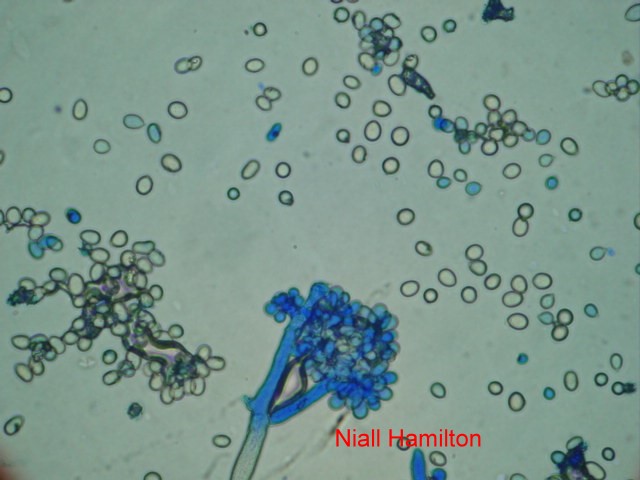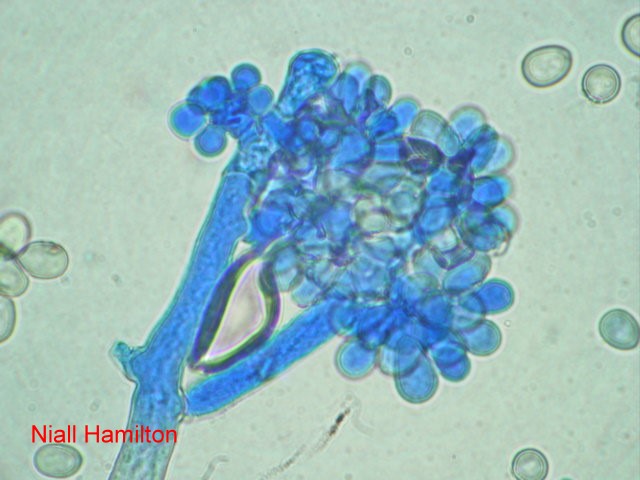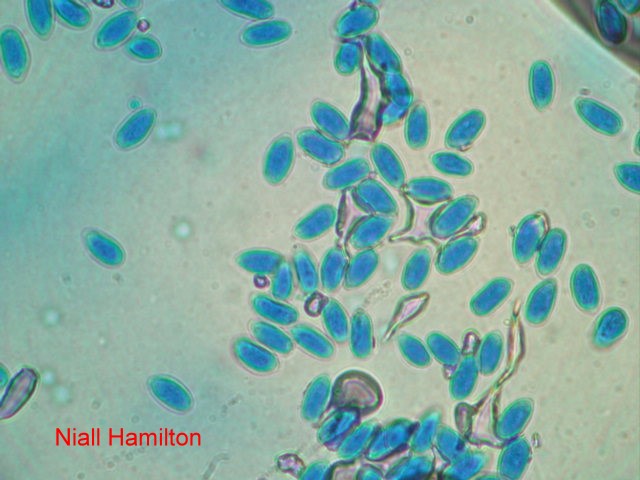
Botrytis cinerea on agar. Note the sclerotia at the bottom of the plate.
Invisible Gardens – the world of mould around us
Part Two: Strawberries and wine
By Niall Hamilton
Firstly – thank you to the people who sent comments regarding the previous article. I welcome any thoughts and feedback.
To answer a question: the stain used in (almost all of) the microscopic images is lacto-phenol cotton blue. The microscope is a Zeiss Axioskop research microscope with a camera attachment (the camera is a Sony Cybershot DSC-H3 Digital Camera).
****************************************
Currently it is mid-summer in my part of the world; the season for BBQ’s, wine and strawberries (well, they are in season). For any microbiologist, wine is about yeast – but quite honestly, yeast aren’t too exciting to look at microscopically. Sure, there are some interesting features to yeast microscopically (& I might talk about that in a later article); but there is a mould that involves both wine and strawberries; Botrytis cinerea, the noble rot.
Anyone who enjoys desert wine is sampling the work of this mould. The stories, of how these wines came about, differs slightly depending on your source – but the central idea is the same. There was a vineyard harvest that was delayed, for whatever reason, and although the grapes of the vine appeared past it, they were still used. The result was a wine sweeter than any other.
How it works (simplified to a few sentences) – the growth of Botrytis on the grape utilizes the available water in the grape, concentrating the sugar content. There are several effects that Botrytis has on the grape, changing the conditions for further fermentation – allowing the wine to remain sweeter. For this to happen, the weather has to be initially wet, but then followed by a dry period. Continued conditions of high humidity promotes the growth of other fungal species (like Penicillium or Aspergillus) and Botrytis overgrowth. The result is “bunch rot” and the grapes are unusable.
Botrytis will also grow on other fruits and berries, though this is fairly destructive growth, rendering the fruit inedible. In particular strawberries can be rapidly overgrown with Botrytis within the course of a day or two.
The name of fungi often gives a reasonable idea as to what to expect. In this case Botrytis roughly means “grape-like cluster” or “bunch of grapes”. The word cinerea relates to ash or smoke. The growth on grapes (or on agar) is a light ash-grey growth. In the image below you can just make out some round black structures near the bottom of the plate. These are sclerotia – fungal mycelia formed into thick walled, hardened masses that will help the fungus weather adverse conditions. The spores (the correct name for asexual ‘spores’ like these is conidia) appear in grape-like masses.
Botrytis is ubiquitous and most grapes or strawberries left too long will start to signs of light powdery ash-grey growth.
As with many of the moulds that people work with; it can cause a form of an allergic respiratory reaction called wine-grower’s lung.
PLEASE NOTE: It’s important to remember that several mould species can be potential pathogens and allergens. Whenever dealing with moulds, it’s best to avoid skin contact or breathing in spores. Slides should be discarded in a disinfectant solution (e.g. 70% ethanol or any house-hold disinfectant) and surfaces should be also be cleaned with a disinfectant solution. Hands can be washed with soap and water.

Botrytis cinerea on agar. Note the sclerotia at
the bottom of the plate.

Botrytis cinerea, 100x magnification.

Botrytis cinerea, 400x magnification

Botrytis cinerea conidia, 1000x magnification
To complement these fairly light-weight/interest pieces on moulds, I will start doing accompanying articles for those interested in the identification and taxonomy of this vast group. Again, any questions or comments are welcomed.
Comments to the author Niall Hamilton are welcomed.
Published in the February 2008 edition of Micscape.
Please report any Web problems or offer general comments to the Micscape Editor .
Micscape is the on-line monthly magazine of the Microscopy UK web site at Microscopy-UK
©
Onview.net Ltd, Microscopy-UK, and all contributors 1995
onwards. All rights reserved.
Main site is at
www.microscopy-uk.org.uk
with
full mirror at
www.microscopy-uk.net
.